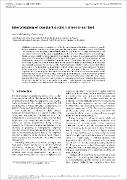Interpretation of constant suction direct shear test
Abstract
Constant suction direct shear test enables the understanding of the failure mechanism in rainfall-
induced landslides. It can be conducted using a conventional direct shear apparatus with some modifications.
The constant suction direct shear test is carried out in two stages. In the first stage, the unsaturated soil
specimen is consolidated to the target net normal stress and matric suction then sheared in the second stage.
Matric suction is usually controlled using the axis-translation principle. It is commonly observed that the
shear stress of an unsaturated soil sheared in the direct shear shows a strain-hardening behaviour at large
displacements making the determination of the failure stress difficult. Hence, the objective of this study is
to critically examine the constant suction direct shear tests and the analysis of the test results to obtain the
shear strength parameters for unsaturated soils. Constant suction direct shear test data were collated from
the literature. It was found that the interpretation of the direct shear test has two inconsistencies: (1) taking
failure shear stress at arbitrary displacement strain or limit, dependent on the size of the direct shear
apparatus, and (2) correcting only shear stress for contact area. The effect of these two consequences on the
interpretation of the direct shear test range from negligible to significant. The study shows that arbitrary
determination of failure shear stress can be resolved by plotting the direct shear test results using a stress-
path plot. The effects of area correction are shown to be almost negligible for small horizontal displacements
of less than 2 mm for both square and circular shear boxes. A more consistent interpretation of the constant
suction direct shear test is demonstrated where both these inconsistencies are considered.

